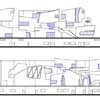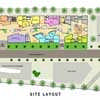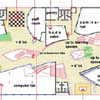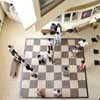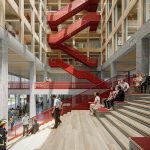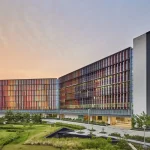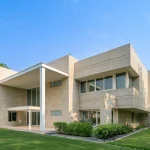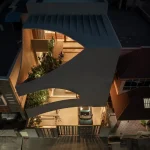Vidyalankar Institute of Technology, Images, Architect, Mumbai Building Design, Project
Vidyalankar Institute of Technology Mumbai Building
Contemporary Indian Architecture – design by Planet 3 Studios Architecture
8 Aug 2011
Vidyalankar Institute of Technology Mumbai
Location: Wadala, Mumbai
Date built: 2008
Architect: Planet 3 Studios Architecture Pvt. Ltd.
Introduction
Breaking new ground with radical re-think of campus architecture in India, this engineering college is devised as an ‘educational village’ consisting of distinct faculty blocks connected by an interior promenade with spaces for student learning activities. Protected from the elements with an oversized roof and a porous skin, the building is uses natural light and ventilation to save energy.
Vidyalakar Institute Of Technology – Educator Narrative
We are committed to an agenda with progressive learning at its heart. We wanted a facility that focused first on the needs of the students, second on the educators and third the management. With decades of experience behind us we had developed a certain ‘academic culture’ that allowed students to imbibe learning in flexible environments & schedules, encouraged informal interactions between students and faculty, promoted holistic mental and physical development of students and encouraged the community at large to participate in the joy of learning.
Unfortunately for us, none of our preexisting facilities enabled the culture to develop and foster to a satisfactory degree. It was felt, for instance that the students did not voluntarily spend the desired amount of time in the institution. The strict formality of the classrooms at Vidyalakar Institute Of Technology discouraged teaming exercises. The teachers sat at some distance from the learning spaces, disallowing spontaneous interactions with the taught. And the existing Vidyalakar Institute Of Technology building presented an impenetrable edifice that distanced itself from the community. We always felt certain disconnect between the aspirations of the institution and the physical spaces that we inhabited.
The new engineering college building project presented an opportunity to do a re-think. In spite of the willingness to do so, we presented a structured design program with clear floor wise requirements to the architects. It was born out of assumptions and modeled on other similar facilities known to us. We however were open to an entirely fresh approach so long as the essential requirements were satisfied.
The architects suggested involving students and educators in the program definition process. We loved the idea. The results of the exercise revealed a lot that we had not initially considered. It also refined our understanding of how the institute actually functioned at a social level. The mandate given to the architects was immediately expanded to discern the subtleties of relationship dynamics between faculties, resources, student groups and with the community.
We also wanted the program to stay anchored to the realities of resources and time available. The architects were required to suggest clever ideas to optimize on construction cost, allocate resources judiciously and manage with the materials & skill of workmen available in a developing country. The Vidyalakar Institute Of Technology building had to minimize its impact on the environment, possess ample natural light and ventilation and use minimum electrical energy in view of the local power deficit. In fact, one of the key design criteria was that each classroom had to have minimum two sides light and ventilation.
The design solution offered for the Vidyalakar Institute Of Technology by the architects caught us by complete surprise. It managed to satisfy the program requirements and go much beyond that. The idea of bringing the campus inside the building was radical. The grouping of requirements into clusters was unusual. The interior promenade with ‘activity pockets’ and many locations for display of student work pushed the envelope.
The first phase of the Vidyalakar Institute Of Technology building has been in use for more than a year. This one building has invigorated the faculty and students alike. The odd shaped flexible learning spaces have induced us to experiment with newer teaching methodologies; students participate much more in informal group learning and impromptu events. There are no gates at Vidyalakar Institute Of Technology, the surrounding community have adopted the street with wi-fi enabled zones as their own and contribute to its upkeep!
Vidyalakar Institute Of Technology – Architect Narrative
This project needed ability to engage a complex design program in an urban, developing country context. The challenge was in articulating the requirements of four distinct engineering faculties within the same building and establishing network accesses to shared amenities. The Vidyalakar Institute Of Technology design had to be simple and intuitive, of equitable use, have flexibility, involve low physical effort, work within context and constraint, communicate ideas visually, be experimentally satisfying, conform to restrictive building codes, demonstrate environmental sensitivity and importantly, to enable future-forward learning concepts.
Eschewing monumental verticality, we chose instead to experiment with horizontal urbanism and hit on the idea of an ‘Educational Village’ built within a container. This literal minded village has various groupings of similar requirements in clearly definable structures with a main ‘Learning Street’ as the central organizing device as well as hospitable site for spontaneous student interactions. This complex of open public spaces, enclosed semi public spaces and private areas has the spatial connectivity of open plan interiors encouraging egalitarian, communal learning experience.
Each programming requirement such as administration, library, several engineering faculties, canteen etc. are individual blocks situated on either side of the inner street. Each such block functions as a self-contained facility with its own faculty, library, learning spaces and connected at various levels with adjacent structures. This street at six feet above ground level sits on a basement containing laboratories, a shared resource between different faculty blocks. Staircases in cutouts on the street lead to the basement below. The building container opens with forty foot wide main entrance and a smaller subsidiary opening to the road outside with no barriers for unrestricted entry.
On the street, helpful signage guide you to your destination with the ease of intuitive logic. We have maintained the intimacy of the human scale and provided numerous activities to promote interaction. Tucked in the alcoves between the Vidyalakar Institute Of Technology blocks, a man sized chess-board, a table tennis court, half a basketball court, a street side café with the canteen block, couple of phone-booths, a book kiosk and a graffiti wall, student work display areas, and a suspended amphitheatre. The act of appropriation of these public spaces by the students becomes a source of cultural energy.
Clusters of classrooms with student interaction zones tucked in-between function as ‘Learning Suites’ at the Vidyalakar Institute Of Technology. Each asymmetrical classroom provides the opportunity to introduce soft seating, teaming zones. Many classrooms have ‘Spill-out Balconies’ that open into the inner street. Wherever required, flexibility to combine two classrooms to form one large space has been provided. Each such learning space has two side windows for natural light and ventilation.
An oversized roof, raised fourteen feet above terrace level shields the inside of the Vidyalakar Institute Of Technology from inclement weather, while allowing hot air to escape from the sides. The building’s public face is a deceptively quiet, porous polycarbonate skin evoking the metaphor of its industrial neighborhood. The skin is engineered to ease glare and yet allow the building to be naturally aerated.
We designed a visually kinesthetic experience of walking through asymmetric spaces, an escape from orthogonal rigidity. Use of recycled materials such as packing material obtained from shipping containers and reengineered sleeper wood from railway tracks in raw form intensify the sense of space.
Vidyalakar Institute Of Technology Mumbai : main page, with photos
Vidyalakar Institute Of Technology – Building Information
Name of the project, Location: Vidyalakar Institute Of Technology, Wadala, Mumbai
Architect, Planner, Consultant: Planet 3 Studios Architecture Pvt. Ltd.
Client: The Vidyalankar educational trust, Wadala-Mumbai
Design team: Kalhan Mattoo, Santha Gour Mattoo, assisted by Jainish Jani
Photographs: Mrigank Sharma – IndiaSutra
Size of the project Built Area: 1, 95,000 sqft
Project Cost: 16 Crores
Brief to the architect
The requirement by Vidyalakar Institute Of Technology was to accommodate four distinct engineering faculties within the same building and to establish network accesses to shared amenities.
Simple and intuitive design, of equitable use,
Experimentally satisfying,
To involve low physical effort,
To have flexibility but still within context and constraint,
To conform to restrictive building codes,
To demonstrate environmental sensitivity and importantly,
To enable future-forward learning concepts.
To enable Institution to develop a serious academic institution brand
Vidyalankar Institute of Technology images / information from Planet 3 Studios Architecture Pvt. Ltd. 080808
Location: Vidyalankar Institute of Technology, Mumbai, India
Indian Architecture
Indian Architecture Designs – chronological list
New Delhi Architecture Walking Tours
Mumbai Development
Design: BDP
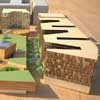
image from architect
Mumbai Development
Nariman Point, Mumbai
Design: Chapman Taylor
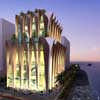
image from architect
Nariman Point Mumbai
Comments / photos for the Vidyalankar Institute of Technology Architecture page welcome

